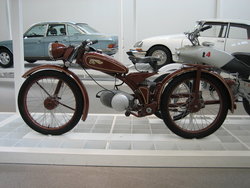Motorcycle
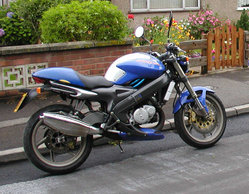
A 125 cc motorcycle, the Italian-manufactured
Cagiva Planet. |
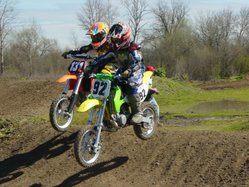
Motocross racing bikes |
A motorcycle (or motorbike) is a two-wheeled vehicle powered by an engine. The wheels are in-line, and at higher speed the motorcycle remains upright and stable by virtue of gyroscopic forces; at lower speeds continual readjustment of the steering by the rider gives stability. The rider sits astride the vehicle on a seat, with hands on a set of handlebars (either a single bar or "clip-on"s which are used to steer the motorcycle, in conjunction with the rider shifting their weight through their feet, which are supported on a set of "footpegs" or "pegs" which stick out from the frame.
History
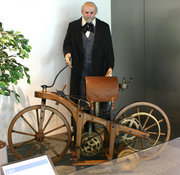
The inspiration for the earliest motorcycles, and arguably the first motorcycle, was designed and built by the German inventors Gottlieb Daimler and Wilhelm Maybach in Cannstatt (a city district of Stuttgart) in 1885. It was the first petroleum-powered vehicle ever and, but for the provision of a pair of stabilizing wheels, a motorized bicycle, although they called their invention the Reitwagen ("riding car"). They had not set out to create a vehicle form but to build a simple carriage for the engine which was the focus of their endeavours.
In the early period of motorcycle history there were many manufacturers as producers of bicycles adapted their designs for the new internal combustion engine. As the engines became more powerful and designs outgrew the bicycle origins, the number of motorcycle producers reduced.
British manufacturers held a dominant position in some markets until the rise of the Japanese manufacturers (led by Honda) in the late 60s and early 70s who were able to produce designs faster, cheaper and of better quality. Today, the Japanese manufacturers Honda, Kawasaki, Suzuki and Yamaha dominate the motorcycle industry, although Harley-Davidson still maintains a high degree of popularity in America.
Construction
Variations
Variations exist:-
- Some motorcycles have floorboards instead of footpegs.
- Some motorcycles can be fitted with a sidecar, this converting it into a 3-wheeler or "hack".
- There are other 3-wheeled variations, commonly referred to as a trike or motortricycle.
- Motorcycle manufacturers often also produce All-terrain vehicles or ATVs. These have two or more back wheels, usually two front wheels, an open driver's seat and a motorcycle-type handlebar. (Early models had a single front wheel, but these were prone to rollovers.) ATVs are used off-road for utility and recreation. However, a proper motorcycle has fewer than four wheels in contact with the ground.
Chassis
The chassis of a motorcycle is typically made from welded aluminium or steel (or an alloy) struts, with the rear suspension being an integral component in the design.
Some motorcycles include the engine as a load-bearing (or stressed) member; this has been used all through bike history but is now becoming more common.
The fuel tank is usually mounted above the engine. This tank is generally made of stamped, brazed or welded sheet metal, or blow molded high-density polyethylene. At least one motorcycle manufacturer (Buell) offer models that use a hollow frame as the fuel tank, and various manufacturers offer designs which use part of the frame as an oil reservoir. The wheel rims are usually steel (generally with steel spokes and an aluminium hub) or 'mag' type sandcast aluminum. Performance racing motorcycles often use carbon-fiber wheels, but the expense of these wheels is prohibitively high for general usage.
A plastic or fiberglass shell, known as a fairing, is placed over the frame in some models to shield the rider from the wind. Drag is the major factor that limits motorcycle speed, as it increases at the cube of the velocity. Despite the streamlined appearance of new performance motorcycles, there is still virtually no aerodynamic technology included in the design, and motorcycles still effectively push their way through the atmosphere with brute force. This is generally due to the fact that no designs have been discovered that can improve aerodynamic performance without unacceptably compromising the rider's ability to control the machine. In the absence of a fairing or windshield, a phenomenon known as the windsock effect occurs at speeds above 100 km/h, where the rider becomes a major source of drag and is pushed back from the handlebars, tiring the rider.
Cabin cycle solved the problem of aerodynamics by isolating driver from outside air.
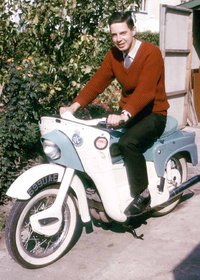
Chassis stability
A good motorcycle chassis has no stability problems.
There could be three kinds of stability problems with motorbikes:
- Capsizing is well known in low speeds, and easy to overcome by going a bit faster.
- Wobbling (AVI movie) is a high frequency (7-9 Hz) oscillation of the front wheel. It is often relatively harmless but annoying (and quite frightening if previously inexperienced). It can appear at moderate speeds.
- Weaving (AVI movie) is a low frequency (2-3 Hz) oscillation of the whole vehicle. It can become unstable at higher speeds with fatal results.
Based on The control and stability analysis of two-wheeled road vehicles:
- The weave oscillations damp out once the rider reduced the roll angle.
- Tyre (tire) characteristics and inflation pressures are important variables in the behaviour of the motorcycle at high speeds.
- From a stability point of view it is desirable to make the lateral stiffness as large as possible, with the possibility of an optimum value for the torsional stiffness of the rear frame.
- Common levels of lateral stiffness at the wheel spindle deteriorates the wobble mode damping substantially with significant changes in the wobble frequency as well, and slight reduction in the weave mode damping at high speeds.
- Lateral distortion should be opposed as much as possible by locating the front fork torsional axis as low as possible.
- The largest contribution to the weave damping came from the cornering and camber stiffnesses and relaxation length of the rear tyre and not so much from the same parameters of the front tyre.
- Amongst others, stiff frames, a long wheelbase, a long trail and a flat steering head angle were found to increase weave mode damping.
- Degraded damping of the rear suspension, rear loading and increased speed amplifies cornering weave tendencies.
- Rear load assemblies with appropriate stiffness and damping were successful in damping out weave and wobble oscillations.
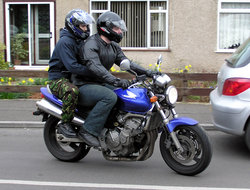
Suspension
Modern designs have the two wheels of a motorcycle connected to the chassis by a suspension arrangement, however 'chopper' style motorcycles often elect to forego rear suspension ("rigid frame").
The front suspension generally consists of sliding steel tubes with long springs inside called forks which use hydraulic fluid for damping shock absorbers. The front fork is the most critical part of a motorcycle. The angle of rake determines how controllable the steering is. The rake should be chosen so that precessive force from countersteer and leaning-steering slightly overbalance the leaning forces from the weight of the bike, at a speed near the running speed of a person. This is the speed at which the rider's feet can no longer be safely used to balance the bike.
The rear suspension supports the swingarm, which is attached via the swingarm pivot bolt to the frame and holds the axle of the rear wheel. The rear suspension can consist of several shock arrangements:
- dual shocks, which are placed at the far ends of the swingarm
- traditional monoshock, which is placed at the front of the swingarm, above the swingarm pivot bolt
- 'Softail' style monoshock, which is mounted horizontally in front of the swingarm, below the swingarm pivot bolt
Brakes
There are generally two independent brakes on a motorcycle, one set on the front wheel, controlled by the right hand lever, and one on the rear controlled by the right foot. In older motorcycles the rear may be on the left foot. However, several models have "linked brakes" which apply both at the same time, although one more than the other. The front brake is generally much more powerful than the rear as roughly 2/3rds of stopping power can come from the front brake when properly applied and in some cases 100% depending on the model of motorcycle and operator; rear wheels can generally lock and skid much more easily than the front due to weight distribution dynamics. Brakes can either be drum or disc based, with disc brakes being more common on large, modern or expensive motorcycles for their far superior stopping power, particularly in wet conditions. There are many brake performance enhancing aftermarket parts available for most motorcycles including brake pads of varying compounds and steel braided brake lines. Some manufacturers have created Antilock braking systems (ABS).
In virtually all cases, 70% to 90% of total braking force should be applied by the front brake when operated on a hard surface such as tarmac, with the remainder being simultaneously applied to the rear brake. Riders fear that aggressive use of the front brake will stop rotation of the tire and cause loss of control, or a skid, and therefore often fail to use the front brake to its full potential. Another common misconception is that application of the rear brake will cause motorcycle instability. The phenomenon known as a "stoppie" may only be achieved if the front brake is used aggressively with no application of the rear brake; if sufficient force is applied to the front brake, the rear of the motorcycle chassis will lift off the roadway, while the bike continues to move forward on the still-rotating front wheel. This is a highly skilled (and generally illegal) maneuver which requires practice to perfect. Trailbraking is a term used to describe carrying the braking action of a vehicle past the turn entry, allowing the rider to adjust speed all the way through a turn to the apex. Another variation of brake use can be seen at top level motorcycle roadracing and motorcross events. The technique of steering the motorcycle in a high speed turn (or lower speeds on a dirt course) using the rear brake is called "backing it in" (or "turning" on dirt). Racers while hard on the front brake will feather the rear brake just enough to start a controlled rear slide, thus rendering a sharper turn angle. Note: This technique is not recommended for public road use.
Engine
Motorcycles have, over time, been powered by an extraordinary array of engines, from very early models powered by steam, to the ubiquitous gasoline engines of today. For a complete discussion, see the main article: Motorcycle Engines.
Transmission
The transmission is controlled by a clutch lever under the left hand in standard configurations, a twistgrip throttle on the right handlebar (where rotating the grip towards the rider increases air and fuel flow to the engine and so causes the bike to accelerate) and a gear lever at the left foot.
The gear lever operates by shifting gears when it is pressed or lifted. A normal street motorcycle is put in first gear by pressing the gear lever, while second and all further gears are reached by lifting it. Downshifting is done by pressing the gear lever. Neutral sits between first gear and second, so a small lift out of first causes the gearbox to change into neutral, but a large movement causes the gearbox to change into second gear. In contrast, racing motorcycles have all gears arranged "below" the first gear, thus pressing the gear lever always shifts up, while lifting it shifts down.
Because there is no way to reach neutral without shifting to second or first gear, it is impossible to double-clutch on a motorcycle. This also means the rider always has to match the transmission speed to the ground speed - shifting to a gear too low for the motorcycle speed accelerates the transmission to a very high speed in only the time the gear shift takes, and would put a great force on the transmission.
Modern motorcycles normally have five or six forward gears. Only the largest touring motorcycles (most prominently, the Honda Goldwing) and a few models that are routinely used with a sidecar are fitted with a reverse gear.
The clutch is typically an arrangement of plates stacked in alternating fashion, one geared on the inside to the engine, and next geared on the outside to the transmission input shaft. Whether wet (rotating in engine oil) or dry, the plates are squeezed together by a spring, causing friction buildup between the plates until they rotate as a single unit, driving the transmission directly. A lever on the handlebar, through a cable or hydraulic arrangement, uses mechanical advantage to release the clutch spring, allowing the engine to freewheel with respect to the transmission.
The most commonly used transmission is a sequential gearbox. From neutral, you may select either first or second gear, but higher gears may only be accessed in order - you may not shift from second gear to fourth gear, without shifting through third gear. Internally, a rotating cam on the shift lever operates cogs on two counter-rotating shafts carrying a variety of gears. One shaft is geared to the final drive mechanism, and the other to the clutch. Operating the shift lever slides individual gears on one shaft, to intersect with a matching gear on the other. The small mass of the whole arrangement allows for extremely quick gear changes. Also, gear synchronizers typically found in passenger cars with manual transmissions are not necessary. The two shafts are always geared together (except in neutral), always spinning at a speed nearly approximating the next higher or lower gear ratio. Aided by beveled edges on the gears, shifting gears is simple for novices - no double clutching or grinding of gears. Advanced drivers can perform "full-throttle upshifts" on racing mounts, but this risks both the warranty and mechanical integrity.
Final drive from the gearbox to the rear wheel is typically accomplished with a chain, which requires both lubrication and adjustment for elongation (stretch) through wear. The lubricant is subject to being thrown off the fast-moving chain and results in grime and dirt buildup. Chains do deteriorate, and excessive wear on the front and rear sprockets can be dangerous. Many motorcyclists replace the chain and both sprockets as a set to maintain efficiency and safety. Many manufacturers offer cruiser models with final drive options of a belt, or a shaft. A belt drive is still subject to stretch, but operates very quietly, cleanly, and efficiently. However, belt drives are limited in the amount of power they can transmit. The belt is frequently toothed. A shaft drive is completely enclosed, the visual cue is a tube extending from the rear of the transmission to a bell-housing on the rear wheel. Inside the bell housing a bevelled gear on the shaft mates with another on the wheel mount. This arrangement is superior in terms of noise, cleanliness, and is virtually maintenance free. However, the additional gearsets are a source of power loss and add to bike weight.
Tires
Motorcycles use pneumatic tires ('tyre' in the UK) which come in many configurations, the most important part of any being the contact patch. That is the small area that is in contact with the road surface while riding.
There are tires designed for dirtbikes, touring, sport and cruiser bikes. Dirtbike tires have knobby, deep treads for maximum grip on loose dirt, mud, or gravel — such tires are very unstable on paved surfaces. Touring tires are usually harder rubber and last longer but provide less grip (significantly less grip while cold, and the heavier rubber takes longer to warm up), while sport/performance tires provide amazing grip but may only last 1,000 miles (1,600 km) or less. Cruisers and "Sport Touring" tires try to find the best compromise between grip and durability. Some cruiser tires have raised white lettering on the sidewalls as a "retro" detail.
Tires should be maintained at the proper air pressure at all times and usually have an average life expectancy of about four to five years. Small cracks on the sidewall or bald spots on the tread are an indicators of the need to replace the tire.
Motorcycle tires can also be found in "race compounds". However, race compound tires should NOT be used in street applications. Race compounds are designed specifically for the short life and few heat cycles of a race environment, where street "DOT" tires are designed for multiple heat cycles and use in a street environment. In most cases street riders will actually achieve higher levels of performance using DOT street tires than race compounds.
If a tire loses grip or goes flat, the rider may crash and make contact in a rather forceful (and very possibly a painful) manner with the road or other obstacles. The motorcyclist must, therefore, consider proper motorcycle attire such as helmet ("full-face" providing the most protection), gloves, boots, and "leathers". Wearing a t-shirt, shorts, and sandals on a motorcycle is not advised. The use of an approved helmet is required by law in many countries (or individual localities therein).
Performance
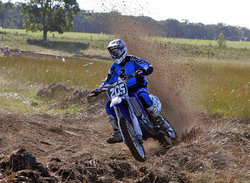
The most efficient way to improve the handling and speed of a motorcycle is via increased operator skill. By attending riding schools and increasing rider education levels, a motorcyclist will be able to ride more skillfully and, thus, more safely. Even experienced riders can benefit from top-level instructors helping to fine-tune their skills, as well as the opportunity to practice crash-avoidance techniques in a more controlled environment (and without risking one's own motorcycle).
The next-most-common cause of loss of speed is one of the easiest to remedy: rolling resistance. The right tires kept at the proper pressure will contribute to both speed and safety.
On the engine, keep the air filter and drive chain (or drive belt) clean, use high-quality lubricants and fuel with precisely-tuned spark plugs, air / fuel mixture, and timing. This is obvious, but often neglected.
Engine modifications can yield appreciable performance improvements, but this is often costly and very time-consuming. Improper attempts at tuning can yield benefits in one particular part of an engine's power band, while impairing performance everywhere else, provoking a net loss of power or handling. Blueprinting, or meticulous restoration of an engine to (or beyond) factory tolerances can help to improve an engine's efficiency and restore power that would otherwise be lost. Enlarging cylinder head ports, while common practice amongst many tuners, is often unnecessary (unless a big-bore kit has been fitted) to the extent that many engines benefit from decreasing the volume in the cylinder head. Done correctly, this increases the velocity of the fuel / air mixture entering the cylinder, packing more mixture in per revolution.
More usable improvements can be had by improving and upgrading suspension components. Suspension is typically the one element of the motorcycle that will receive the least amount of engineering attention from the factory. Replacing stock shocks and fork springs as well as changing damping and valving rates will result in dramatic improvements in motorcycle stability and increased speed and rider confidence as a result.
Another way to increase performance is to install a tuned exhaust system. This helps evacuate the exhaust from the engine more rapidly, and permits a longer power-stroke. However many modern production bikes already have tuned exhausts. A "custom" tuned exhaust will often operate only at a narrower range of engine RPM, and therefore more suited to more specialised applications, usually racing (road or drag).
Aftermarket exhaust systems are usually louder, by varying degrees, than stock systems. Most countries have limits on how much noise can legally be produced by vehicles, however this usually does not deter motorcyclists from fitting louder exhaust systems. There is even a school of thought that louder systems are safer, as they attract the attention of (car) drivers, who might otherwise have failed to notice the motorcyclist.
One of the most effective ways of increasing power is forced induction. Turbochargers are generally more effective than superchargers because turbos spin using the exhaust gases while a supercharger uses engine power to spin it directly (usually via a belt system), robbing power. Since more air is being forced into the engine, the air/fuel ratio must be changed to prevent the engine from running lean [and potentially destroying itself]. On low boost settings, the turbocharger can increase power and fuel range. Engine internals such as pistons and connecting rods must be replaced with stronger ones for all but the smallest boost. In addition, the compression ratio must be considered and adjusted accordingly, as an "overboosted" engine will destroy itself as well.
With great care, an engine can be helped to "sprint" by injecting small amounts of nitrous oxide (N2O). The main benefits of nitrous oxide are three-fold —
- More oxygen is introduced into an engine's combustion chamber
- As nitrous oxide is stored in liquid form, it is still very cold when it evaporates and is mixed with fuel. This chilling effect raises the density of the mixture, packing more fuel and oxygen into the combustion chamber.
- This colder mixture helps to keep the engine running cooler, which is very useful as nitrous oxide is almost exclusively used in stressful, high RPM situations, primarily drag racing.
Engines using large amounts of nitrous oxide need precise mixtures and/or configurable timing and carburation. It's very easy to blow the head gaskets or burn the valves of the engine with careless nitrous oxide injection. Using methods like nitrous oxide are fine on dragstrips, but while not illegal, can be very dangerous on the street. In any case, a canister of nitrous oxide is rapidly expended, and impractical for sustained use on a road-going bike by any sane rider.
Instruments
Almost all motorcycles have a speedometer and odometer and many have a tachometer. Fuel gauges are becoming more common, however traditionally a reserve tank arrangement has been used with a petcock on the side of the motorcycle allowing the rider to switch to a reserve fuel supply when the main fuel supply is exhausted; this is typically done while the vehicle is in motion. There is not actually a separate reserve tank, the intake for the petcock has two pipes, one extending higher into the fuel tank than the other, when fuel no longer covers the long pipe the rider switches to the shorter pipe. Riders without a fuel gauge usually learn how many miles / km they can do with a full tank of fuel, and then use a trip meter if available to judge when they must refill the tank.
Motorcycle types
Motorcyles have been built in a myriad of different models for innumerable different purposes. For a complete discussion of contemporary motorcyle types, see the main article: Types of Motorcycle
Safety
Motorcycles have a far higher rate of crippling and fatal accidents per unit distance than automobiles. According to the US Highway Safety Authority, in 2002 20.9 cars out of 100,000 ended up in fatal crashes. The rate for motorcycles is 66.7 per 100,000. Given that motorcycles cover less distance than cars per year on average, the figure per unit distance is likely to be much worse.
For a complete discussion, see the main article: Motorcycle Safety
Culture
Gangs and Counter-Culture Movements
Across the world, and both past and present, motorcycles have been associated with subcultures of society. Some of these subcultures have been loose-knit social groups such as the Cafe racers of 1950s Britain, and the Mods and Rockers of the 1960s. Others are purportedly fraternal organizations, the most well known of these being the Hells Angels. Most motorcycle orgaizations have law-abiding and peaceful members, and many raise money for charities through organized events and rides. Gangs represent far less than 1% of motorcyclists.
Risk Taking
Motorcycles are typically more agile, can accelerate quicker, and are generally perceived to be more fun to ride than an average car. Because of this, they sometimes attract people — typically, but not exclusively, young men — with a propensity to take great risks or behave dangerously and anti-socially. These people contribute significantly to the fatality and injury rates of motorcyclists.
The U.S, U.K. and Europe are also seeing a surge in motorcycle ownership, thanks in large part to an older demographic, people in their 40's and 50's. Many of these riders are either new to the sport, or have not been on a motorcycle for many years; they would benefit from rider training as much or more so than any new rider. A substantial increase in the number of riders (regardless of age) indicates a greater number of inexperienced riders, who are more likely to be involved in accidents. See Born again biker.
Public Perception
In less developed nations, motorcycles are often the only motorized transportation affordable to the majority of the population. In much of the developed world, motorcycles are thought of as a cheap and efficient means of transportation, but they are tainted by a stereotype of riders as anti-social and reckless, even though the majority are safe and law-abiding.
This is because the very small number of events where a non-motorcyclist is offended by a motorcyclist (perhaps by excess exhaust noise, reckless behaviour, or news reporting of a motorcycle gang incident) are amplified in popular thought. This phenomenon is known by sociologists as availablity error, and all minority groups in society tend to fall afoul of it.
In American speech, the term biker has come be be associated with members of the gangs described above. Many of those who ride motorcycles prefer the more neutral terms "rider" or "motorcyclist." In Australia and New Zealand the word "bikie" is used instead of "biker".
Clannishness and Brand Loyalty
Like most minority cultures, motorcyclists in developed countries "stick together." Most cities have several bars and hangouts where riders congregate. When riders pass each other in the opposite direction, riders often wave or nod. Riders will sometimes stop and help if another rider has broken down.
Within motorcycle culture, people congregate around brand names, type of bike, and individual models.
Brands
Most manufacuturers subsidize a club to foster a sense of community between, provide services to, and make money from the owners of their bikes. Such clubs include:
- Harley Owners Group (HOG)
- Riders of Kawasaki (RoK)
- Honda Owners Club
BMW Motorrad has no national owners clubs, but, uniquely, has many independent clubs in different countries, such as BMW Motorcycle Owners of America (BMWMOA) and BMW Riders Association (BMWRA).
Types
Many interest groups form around a particular type of riding or style of bike:
- Track Racing (sport bikes)
- Adventure Touring (dual-sport bikes)
- Touring and Motorcycle camping (touring and dual-sport bikes)
- Minibikes or Pocket-Bikes as used in Pocketbike racing
Models
Some individual bikes almost develop a cult following:
Rallies
- Daytona Bike Week [1]
- Laconia Motorcycle Week [2]
- Port Dover Friday the 13th [3]
- Sturgis Motorcycle Rally [4]
Related articles
- American Motorcyclist Association
- List of motorcycle manufacturers
- List of Honda motorcycles
- Motorcycle racing
- Motorcycle leathers
- Helmet law defense league
- Motorcycle helmet
- Feet forwards motorcycle
- Countersteering
- Trailbraking
- Chicken strips
- Pillion
- Rockers
- Cafe racers
External Resources
- BikeTome - a dedicated motorcycle wiki
- SteelBiker -Links to Motorcycle needs
- Motorcycle-Blog.com - Weblog on motorcycles
- StuntLife.com - Sportbike stuntrider website
- Pashnit - Collection of over 300 great motorcycling roads in California
- Hurt Report

